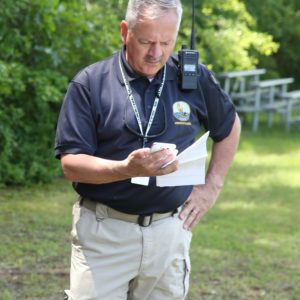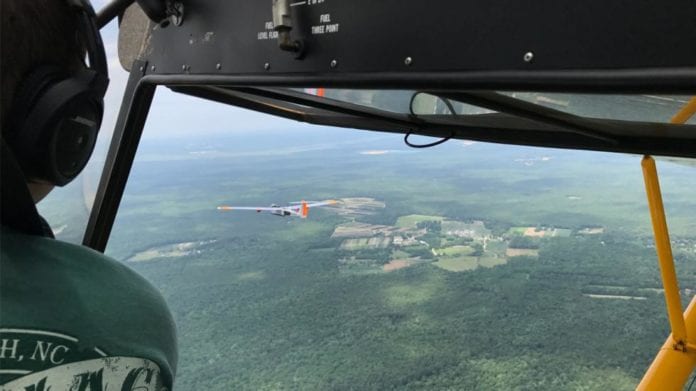The small, gray aircraft with bright orange under-wings looked like a large model plane, but the civilian drone carried an unusual passenger: electronic equipment that turned the unmanned aerial vehicle into a flying cell site.
As the drone flew on a predetermined path with a chase aircraft following, first responders on the ground were able to connect their devices to the flying cell site. The demo was held in conjunction with Cape May County’s Office of Emergency Management to conduct a disaster recovery simulation drill, supported by

Verizon and drone company American Aerospace Technologies.
“We put base station electronics into the payload area of this relatively large civilian drone,” said Chris Desmond, principal engineer and Verizon’s lead subject matter expert for the deployment of unmanned aircraft systems. Although the equipment was a small “cell,” Desmond said it was a customized piece of electronic equipment rather than an actual small cell.
The UAV, with a 17-foot wingspan, can fly up to 16 hours straight, according to Desmond, so it lends itself well to long-duration missions such as providing coverage for disaster recovery. American Aerospace Technologies paired the drone with a mobile operations center on the ground, which Desmond compared to a small cell site shelter on the bed of a large pickup truck. Backhaul was provided over unlicensed spectrum from the drone to the mobile operations unit, which was then connected via a Verizon LTE modem to a local base station. The first responders on the ground were able to have regular smartphone data sessions, from sharing texts and pictures to voice calls. Verizon had tailored its service in the area so that customers were moved to other bands and the drone provided the only coverage in the area for the disaster recovery simulation drill.
It’s Atlantic hurricane season, and disaster recovery capabilities are top-of-mind in states that are potential hurricane targets. The demo was also a chance for Verizon to remind public safety customers that it is working on innovative public safety wireless solutions — even as the new First Responders Network Authority LTE network is capturing the attention of states as they decide whether or not to opt in to the national network build-out by AT&T.
FirstNet continues to pick up states that are opting in to AT&T’s national network build. Iowa is the latest state to join the FirstNet effort, bringing the total to five as of this week. But opting in doesn’t obligate a state’s first responders to use FirstNet — it simply means that AT&T, rather than the state, will design and build the Radio Access Network for FirstNet access. However, AT&T is wooing new public safety customers with offers such as the fact that once a state opts in to the network build, its first responders can take advantage of prioritization on AT&T’s existing network without additional charges.
FirstNet/AT&T will be looking to gain public safety customers from the existing market, and that inevitably means seeking to poach customers from Verizon and Sprint.
“If you look at the public safety organizations that are out there, many of them rely on Sprint and Verizon as we speak,” said Ken Rehbehn, principal analyst at Critical Communications Insights. “AT&T is going to be expanding its market share considerably, on the back of this FirstNet network.”
Rehbehn noted that FirstNet has now spent years reaching out to states and territories to get familiar with their public safety communications needs — which also serves as marketing for FirstNet, which is focused not just on providing a network for public safety, but devices and integrated applications with the aim of advancing the overall communications ecosystem for first responders.
“I think we can expect the competition to package offers that will stand up against AT&T,” Rehbehn said. “Where AT&T will have an edge will be with a core network, and a trusted core in terms of the security mechanisms. … Agencies will have to ask themselves, ‘What is the value of the core? Do we need to have our services running through that core?’ If the answer is yes, I think it’s inevitable over time that that will happen, but today we don’t really have that core in place.” In addition, Rehbehn added, “it’s very important for FirstNet to foster the application environment that gives the network its reason to be,” said Rehbehn. “It’s not just about radio access.”
But Verizon says it’s not concerned. Mike Maiorana, SVP of sales for the public sector at Verizon, said that the carrier has “a significant business in this segment” that it has built up over two decades with its network message focused on reliability and quality.
“We’ve got a marketing message that ‘better matters,’ meaning our network, our customer service, our product portfolio and our solutions,” said Maiorana. “We really believe that nowhere does ‘better’ matter more than for public safety and first responders.
“We’re feeling really good that we can continue to be a very strong partner for these customers,” he added. He said that Verizon is looking at how it can implement preemption features in addition to the priority services that it already offers, and that its ongoing network investments in LTE Advanced features, densification and overall network capacity will benefit first responders — as well as its extensive rural roaming agreements for coverage.
“Priority is great, but only if you’ve got the network already there to leverage,” Maiorana said. He declined to give any details about what Verizon’s competitive response to the emergence of FirstNet might be, but emphasized that Verizon’s network will continue to give the carrier an advantage in the market.
“Over the years, we’ve earned the trust and confidence of federal, state and local public safety, law enforcement and first responder customers by delivering the best services on the market, that they can count on from a coverage, capacity, reliability and performance perspective — and at the end of the day, that’s what matters most to this segment,” Maiorana said.

